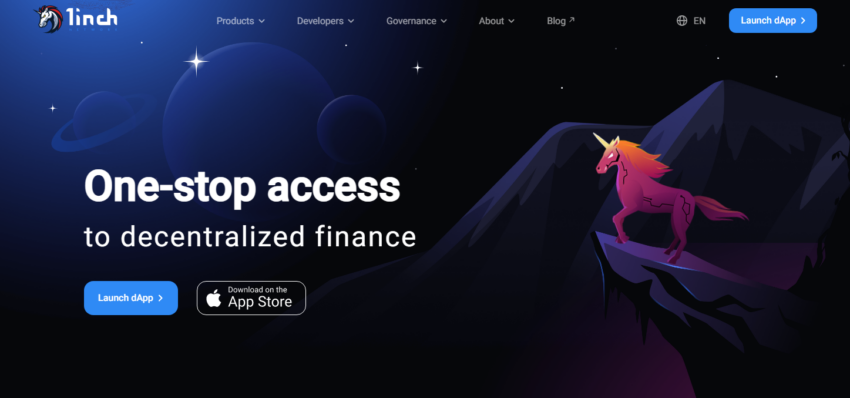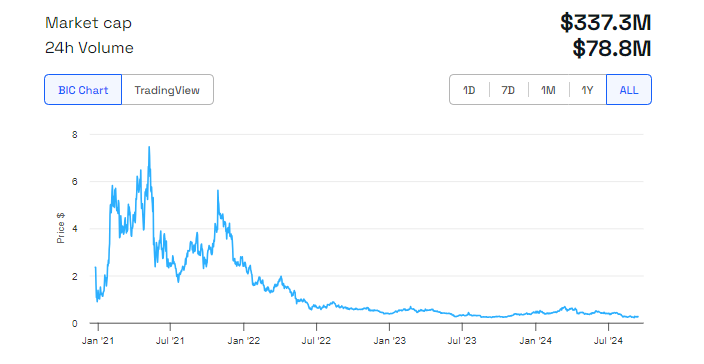1inch exchange is a decentralized exchange (DEX) that makes the DeFi ecosystem more accessible to the average cryptocurrency trader. It expands on the possibilities offered by other DEXs and offers the cheapest route for your trade. Learn more about 1inch in this comprehensive guide.
KEY TAKEAWAYS
• 1inch is a decentralized exchange aggregator that helps users find the best crypto swap prices by splitting orders across multiple DEXs.
• It offers features like liquidity aggregation, limit orders, multi-chain integration, and zero service fees on select trades.
• The platform uses its native 1INCH token for governance and utility, and the Chi Gastoken to reduce gas costs.
• 1inch provides decentralized trading solutions that can offer better control and ownership of assets than centralized exchanges.
What is 1inch Exchange?

1inch Exchange is a decentralized exchange aggregator platform that incorporates two different functions:
- DEX swaps
- DEX aggregation
The 1inch DEX platform allows you to buy and sell cryptocurrencies, and in many ways, it is similar to Uniswap DEX.
What sets the 1inch exchange apart from other DEXs is its DEX aggregator feature. This feature searches for the best prices from a lot of decentralized exchanges for its customers and tries to ensure the best possible rates for exchanging cryptocurrency.
The 1inch DEX aggregator checks several routing options for each specific trade. It can also split funds into smaller amounts and exchange them on different DEX, thus ensuring the lowest prices.
The 1inch exchange uses arbitrage bots to split and trade orders on multiple DEXs to find the best market price. While this operation could also be done manually, 1inch can do it within one transaction and at a very fast pace.
Slippage is not a negligible concern for DEX users, especially when trading large orders on illiquid markets. Splitting orders over multiple DEXs also decreases the slippage fees, which means better trades for customers.
1inch is a platform that gives DEX users the best choice and prices for their swaps. As with all DEXs, there is no need to complete the KYC process or have an account to use the platform.
Evolution of 1inch Exchange

1inch was founded in March 2019 by two Russian developers, Sergej Kunz and Anton Bukov. But even before that, Kunz was hosting live streams on YouTube in which he would audit Ethereum smart contracts security.
The two developers also attended some international hackathons, which brought them sponsorship from MarkerDAO, Set Protocol, and Kyber Network.
The two developers were experimenting with arbitrage bots and created the first 1inch Exchange blueprint before attending the ETHNewYork convention. They created the 1inch Exchange MPV during the event, which aggregated liquidity from DEXs, including Bancor, Kyber, and Uniswap.
1inch Exchange features
1inch connects to multiple DEXs and DeFi platforms, including Uniswap, SushiSwap, Compound, Yearn.finance, and Bancor. The main features of the 1inch Exchange are:
- Liquidity protocol
- Aggregation protocol
- Limit order protocol
- Multi-chain integration
- Low trading fees
Liquidity protocol
The first focus of the 1inch protocol was to aggregate liquidity from other DEXs. However, the team also developed a liquidity protocol that would attract native liquidity to 1inch.
The liquidity protocol stands at the core of the 1inch Exchange and its Mooniswap AMM. Anybody can deposit assets in a 1inch liquidity pool. However, 1inch failed to attract LPs from other AMMs, despite launching its liquidity protocol using a liquidity mining program.
Aggregation protocol
In March 2021, 1inch announced its v3 aggregation protocols and upgraded smart contracts. As a result of this upgrade, the 1inch DEX aggregator became faster and more efficient.
1inch V3 connects to more DEXs via Ethereum, Binance Smart Chain, and the other chains. Traders can easily access liquidity from the main DEXs on different chains.
Limit order protocol
Most traders avoid DEXs because they lack advanced trading tools such as limit orders. However, 1inch Exchange goes the extra mile with its limit order protocol.
Traders can place stop-loss orders, trailing-stop orders, and auctions. The 1inch limit order protocol does not charge any fees.
Multi-chain integration
Most DeFi applications exist on the Ethereum network. However, the expensive Ethereum transaction fees keep many investors away from the ecosystem. That’s why 1inch Exchange integrated several other blockchains, including Binance Smart Chain (BSC), Gnosis Chain, and Avalanche — as well as popular Ethereum layer-2 solutions (Polygon, Optimism, and Arbitrum).
1inch’s BSC deployment offers the same functionality as its Ethereum counterpart. Instead of routing to Uniswap or Sushi, 1inch’s BSC route to PancakeSwap and Venus Protocol.
Low trading fees
1inch does not charge any service trading fees, regardless of the size of your trade. However, traders will still have to pay the trading fees that are incurred from trading on the other exchanges. Often, trading fees are the same, if not even lower, as when you’re using Uniswap or Curve directly.
How does 1inch work?

Users of 1inch Exchange can initiate their DEX transaction, and then 1inch splits the order amongst different DEXs to provide the best possible price. Users can also edit the slippage percentage and gas fees to process the transaction, which will influence the processing time.
The core principle of 1inch is to find the best and most cost-effective route to exchange cryptocurrency. Generally, exchanging crypto isn’t a simple swap between two assets, and the exchange must execute multiple trades before it obtains the desired asset.
This is especially true if the crypto you are looking to exchange isn’t one of the most popular assets.
For instance, if you would like to exchange wBTC to LINK, the route could be wBTC to WETH to LINK if no exchange offers a liquidity pool that provides those two specific assets.
While most DEXs offer this kind of routing, 1inch does it across different exchanges in its pursuit of finding the best possible rates.
The main aspects of using 1inch exchange are:
- User-friendly interface
- No extra transaction fees: The users only pay for transaction fees on the blockchain, but the 1inch exchange doesn’t charge any fees.
- Low swapping fees: Users can choose between different exchanges and can actively choose the best prices and gas fees.
- LP tokens can be used for yield farming.
- It’s a secure platform.
- Favorable crypto rates: The 1inch Pathfinder feature makes it easy for users to find the best available rates for cryptocurrency exchanges.
- Increase liquidity: As a DEX aggregator, 1inch is connected to over 50 DEXs, which hold a significant amount of liquidity.
How to use 1inch exchange
Anyone can use 1inch Exchange. You need to connect your wallet to the platform. The application supports some of the most popular cryptocurrency wallets, including MetaMask, Coinbase Wallet, and other wallets supported by WalletConnect.
For all 1inch swaps, users are in control of most aspects of their trade, including:
- Gas price: It can be set to low, medium, high, and instant.
- Slippage tolerance: The minimum slippage amount is 0.1%.
- Partial fill: Can choose to fill their order partially, to avoid transactions from being reverted and losing their gas fees.
- Compatibility mode: This option can be useful for tokens that charge internal commissions.
- Use legacy transaction type.
- Liquidity sources: 1inch users can choose to use or avoid specific sources from the liquidity sources available.
- Custom tokens: Users can add tokens to this list using their smart contract address.
There is also an option to place limit orders on the 1inch exchange.
How does 1inch far against competitors?
While DEXs are the safest way for crypto investors to trade their coins, the platforms may face some issues when dealing with large trades.
Moreover, some of the smaller DEXs, with limited liquidity, may become unattractive for traders, as they can’t perform token swaps of large amounts and also face sharp price fluctuations.
However, DEX aggregators have the power to change that and benefit all the actors involved in the DeFi scene, solving issues related to low liquidity or high commission fees. While 1inch is the largest DEX aggregator, others also exist. The main 1inch competitors are:
- Paraswap
- Matcha
- CoW Swap
| Aggregator | Token | Blockchains | Exchanges |
|---|---|---|---|
| 1inch | 1INCH | 12+ | 50+ |
| Paraswap | PSP | 9+ | 56+ |
| Matcha | N/A | 7+ | 50+ |
| CoW Swap | COW | 3+ | N/A |
Many DEX aggregators have similar properties. However, while many tend to aggregate from the same sources of liquidity, platforms like Matcha have added bridging features.
Moreover, protocols like CoW Swap aggregate or employ specialized operators to find the best routes for their customers rather than aggregating the exchanges themselves. This allows customers to swap and utilize special order types with zero gas fees.
Roadmap and development history
The MVP of the 1inch protocol launched during the ETHNYC Hackathon and initially sourced its liquidity from Uniswap, Bancor, and Kyber. Since the launch, the exchange has received around $190 million through its seed, Series A, and Series B funding rounds.
The aggregator launched its own AMM (automated market maker), called MooniSwap, in Aug. 2020. Mooniswap was designed to stop front-running and be a next-generation AMM. The DEX introduced five-minute price delays, forcing arbitrageurs to trade at lower profit prices. This mechanism theoretically lowers impermanent losses for liquidity providers and generates more profit.
A few months later, in Nov. 2020, the 1inch V2 was released. This upgrade was primarily about updating the 1inch Aggregation Protocol and replacing the outdated routing algorithm with Pathfinder. It is an API that finds the best swap route faster than before.
Pathfinder can split swaps among multiple liquidity sources and even use different market depths within a single liquidity source for a single Swap. It also considers gas consumption.
In Dec. 2020, the 1INCH token launched along with the 1inch DAO. Holders can stake this token on the 1inch exchange, and also use it for governance.
On Jun. 10, 2021, the 1inch Limit Order Protocol went live. This upgrade replaced the legacy solution forked from 0x and provides a more gas efficient protocol.
What is 1INCH token?

1inch exchange introduced the 1INCH token on Dec. 25, 2020. The token serves as a governance token and utility token for 1inch’s AMM, and DEX. Similar to the Uniswap token launch, the 1INCH token was airdropped to the liquidity providers of the exchange.
All addresses that traded on the platform prior to Sep. 15, 2020, or made at least four trades with a total of at least $20 received the token. The protocol gave away 90 million 1INCH tokens. These tokens are used on the 1inch DAO (decentralized autonomous organization) to vote on the platform’s future developments.
1INCH token has the following main use cases:
- Utility: The token can be used on the 1inch Liquidity Protocol as a connector to help achieve efficient token swap routing.
- Governance: The token is needed for all governance voted on the 1inch Network.
- Multi-chain: The token is available on the Ethereum and the BSC networks.
1INCH tokenomics
There is a maximum supply of 1,500,000,000 1INCH tokens. Out of the total supply, 6% of the 1INCH tokens were distributed during the first airdrop. The remaining tokens are planned to be fully released until Dec. 24, 2024.
Token distribution:
- Community incentives: 30%
- Backers 1: 18%
- Network growth fund: 14.5% (to issue grants and incentivize developers)
- Backers 2: 12.2%
- Core contributors: 22.5%
- Small backers: 2.3%
What is Chi Gastoken (CHI)?
The Chi Gastoken was introduced in June 2021. It is a gas token and a key feature of the 1inch network. The token allows users to reduce Ethereum gas costs, and it works as tokenized gas.
Traders can buy Chi tokens when gas prices are low and then use them later when gas fees might increase.
The price of the Chi token is tied to the Ethereum network’s gas price. This allows users to benefit from reduced gas fees during times of high network congestion. Traders can, therefore, save money during peak trading hours. Read more about the Chi token on the 1inch blog.
Is 1inch exchange the future of DeFi?
1inch Exchange will likely continue to play a key role in future developments of the DeFi space, especially on the Ethereum network. Newbie DeFi users might find decentralized exchanges more difficult to navigate than centralized offerings like Binance or Coinbase. However, centralized exchanges are still subject to downtime or certain limitations, especially during high price volatility times. Aggregators like 1inch Exchange can help fill the gap and help crypto traders find the best available prices in 2025.
Disclaimer: This article is for informational purposes only and should not be considered investment advice. Using decentralized exchanges carries risk. Never invest more thna youo can afford to lose and prioritize security at all times.
Frequently asked questions
What is 1INCH used for?
Is 1INCH a good investment?
What is 1inch coin?
What is unique about 1inch?
Is 1inch a good exchange?
Is 1inch related to Uniswap?
Disclaimer
In line with the Trust Project guidelines, the educational content on this website is offered in good faith and for general information purposes only. BeInCrypto prioritizes providing high-quality information, taking the time to research and create informative content for readers. While partners may reward the company with commissions for placements in articles, these commissions do not influence the unbiased, honest, and helpful content creation process. Any action taken by the reader based on this information is strictly at their own risk. Please note that our Terms and Conditions, Privacy Policy, and Disclaimers have been updated.





